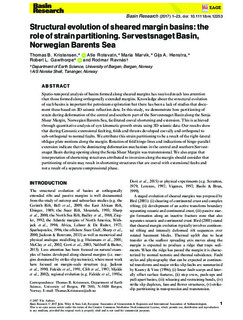| dc.contributor.author | Kristensen, Thomas Berg | |
| dc.contributor.author | Rotevatn, Atle | |
| dc.contributor.author | Marvik, Maria | |
| dc.contributor.author | Henstra, Gijs Allard | |
| dc.contributor.author | Gawthorpe, Robert | |
| dc.contributor.author | Ravnås, Rodmar | |
| dc.coverage.spatial | Norwegian Barents Sea | nb_NO |
| dc.date.accessioned | 2019-05-14T09:20:19Z | |
| dc.date.available | 2019-05-14T09:20:19Z | |
| dc.date.created | 2017-08-24T09:23:20Z | |
| dc.date.issued | 2017-07 | |
| dc.identifier.citation | Kristensen, T.B., Rotevatn, A., Marvik, M. et al. (2018) Structural evolution of sheared margin basins: the role of strain partitioning. Sørvestsnaget Basin, Norwegian Barents Sea. Basin Research, 30(2), pp. 279–301 | nb_NO |
| dc.identifier.issn | 0950-091X | |
| dc.identifier.uri | http://hdl.handle.net/11250/2597533 | |
| dc.description.abstract | Spatio-temporal analysis of basins formed along sheared margins has received much less attention than those formed along orthogonally extended margins. Knowledge about the structural evolution of such basins is important for petroleum exploration but there has been a lack of studies that document these based on 3D seismic reflection data. In this study, we demonstrate how partitioning of strain during deformation of the central and southern part of the Sørvestsnaget Basin along the Senja Shear Margin, Norwegian Barents Sea, facilitated coeval shortening and extension. This is achieved through quantitative analysis of syn-kinematic growth strata using 3D seismic data. Our results show that during Cenozoic extensional faulting, folds and thrusts developed coevally and orthogonal to sub-orthogonal to normal faults. We attribute this strain partitioning to be a result of the right-lateral oblique plate motions along the margin. Rotation of fold hinge-lines and indications of hinge-parallel extension indicate that the dominating deformation mechanism in the central and southern Sørvestsnaget Basin during opening along the Senja Shear Margin was transtensional. We also argue that interpretation of shortening structures attributed to inversion along the margin should consider that partitioning of strain may result in shortening structures that are coeval with extensional faults and not a result of a separate compressional phase. | nb_NO |
| dc.language.iso | eng | nb_NO |
| dc.publisher | John Wiley & Sons Ltd. | nb_NO |
| dc.relation.uri | http://onlinelibrary.wiley.com/doi/10.1111/bre.12253/full | |
| dc.rights | Navngivelse-Ikkekommersiell 4.0 Internasjonal | * |
| dc.rights.uri | http://creativecommons.org/licenses/by-nc/4.0/deed.no | * |
| dc.subject | geologi | nb_NO |
| dc.subject | geology | nb_NO |
| dc.subject | Barentshavet | nb_NO |
| dc.title | Structural evolution of sheared margin basins: the role of strain partitioning. Sørvestsnaget Basin, Norwegian Barents Sea | nb_NO |
| dc.type | Journal article | nb_NO |
| dc.type | Peer reviewed | nb_NO |
| dc.description.version | publishedVersion | nb_NO |
| dc.rights.holder | © 2017 The Authors | nb_NO |
| dc.subject.nsi | VDP::Mathematics and natural science: 400::Geosciences: 450 | nb_NO |
| dc.source.pagenumber | 279–301 | nb_NO |
| dc.source.volume | 30 | nb_NO |
| dc.source.journal | Basin Research | nb_NO |
| dc.source.issue | 2 | nb_NO |
| dc.identifier.doi | 10.1111/bre.12253 | |
| dc.identifier.cristin | 1488262 | |
| cristin.unitcode | 217,8,6,0 | |
| cristin.unitname | Institutt for petroleumsteknologi | |
| cristin.ispublished | true | |
| cristin.fulltext | original | |
| cristin.qualitycode | 2 | |

